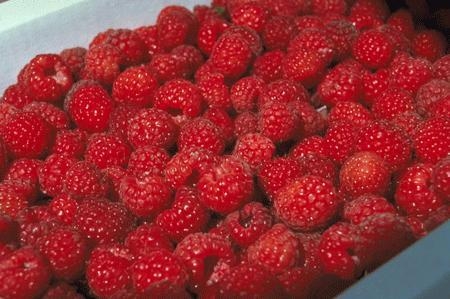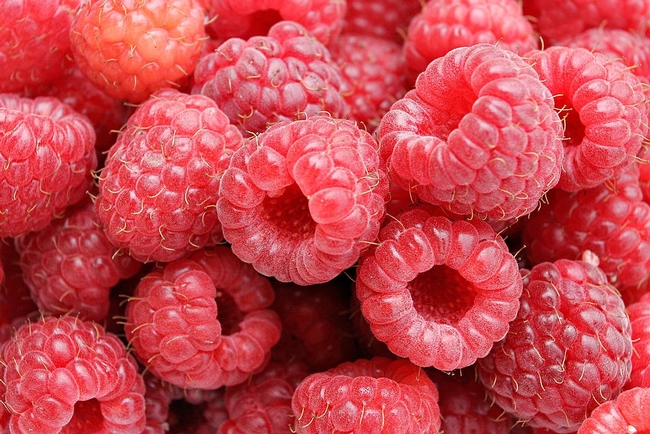Posts Tagged: Raspberries
Growers get help from UC in estimating raspberry production costs
When growers are considering a new crop to plant, and penciling out their expenses and income, cost estimates from the University of California may help. A new cost and return study for commercially producing raspberries released by UC ANR Agricultural Issues Center and UC Cooperative Extension includes an expanded section on labor.
Sample costs to establish, produce and harvest raspberries for fresh market in Santa Cruz, Monterey and San Benito counties are presented in “Sample Costs to Produce and Harvest Fresh Market Raspberries in the Central Coast Region – 2017.”
“The study focuses on the many complexities and costs of primocane raspberry production over a three-year period, including crop establishment, fertility practices, overhead tunnel management, harvest and rising labor costs," said Mark Bolda, UC Cooperative Extension farm advisor and co-author of the study.
The analysis is based upon a hypothetical well-managed farming operation using practices common to the region. The costs, materials, and practices shown in this study will not apply to all farms. Growers, UC Cooperative Extension farm advisors and other agricultural associates provided input and reviewed the methods and findings of the study.
“This raspberry cost and return study is the result of significant effort on the part of UC Cooperative Extension, the Agricultural Issues Center and several grower and industry collaborators, who shared their expertise and contributed mightily to the end product,” said Laura Tourte, UC Cooperative Extension farm management advisor and co-author of the study.
This study assumes a farm size of 45 contiguous acres of rented land. Raspberries are planted on 42 acres. The crop is hand-harvested and packed into 4.5-pound trays. There is a fall harvest during production year 1, a spring and fall harvest during production year 2, and a spring harvest during production year 3. Each harvest is three months long.
The authors describe the assumptions used to identify current costs for production material prices and yields. Tables show the phase-in schedules for California's minimum wage and overtime laws through the year 2022. Other tables show the monthly cash costs, the costs and returns per acre, hourly equipment costs, and the whole farm annual equipment, investment and business overhead costs.
Free copies of “Sample Costs to Produce and Harvest Fresh Market Raspberries in the Central Coast Region - 2017” can be downloaded from the UC Davis Department of Agricultural and Resource Economics website https://coststudies.ucdavis.edu. Sample cost of production studies for many other commodities are also available at the website.
The cost and returns studies program is funded by the UC Agricultural Issues Center and UC Cooperative Extension, both of which are part of the UC Division of Agriculture and Natural Resources, and the UC Davis Department of Agricultural and Resource Economics.
For additional information or an explanation of the calculations used in the studies, contact the UC Agricultural Issues Center at (530) 752-4651 or UC Cooperative Extension advisors Mark Bolda at (831) 763-8025 or Laura Tourte at (831) 763-8005 in Santa Cruz County.
Hoop houses sprouting along Santa Barbara County roadways
The "Roadside Attractions" column in the Santa Maria Times today comments on the increasing number of hoop houses seen along Santa Barbara County highways and byways.
Hoop houses, long white tents also known as tunnels, shelter raspberries, the article said.
“There’s been a dramatic increase in berry growing in the county,” said Mark Gaskell, UC Cooperative Extension advisor for San Luis Obispo and Santa Barbara counties.
Hoop houses essentially serve as mini-greenhouses. Made of plastic stretched over hoops, they control heat and humidity and shelter plants from wind.

Hoop houses help growers regulate the raspberry ripening process so the delicate fruit can reach markets at an opportune time.
New UC studies examine cost of producing beef, alfalfa hay, corn silage, rice, prunes, raspberries and avocados
New studies showing production costs for beef, alfalfa hay, corn silage, rice, prunes (dried plums), raspberries and avocados (conventional and organic) are now available from the University of California Cooperative Extension.
Each analysis is based upon hypothetical farm operations using practices common in the region. Input and reviews were provided by farm advisors, researchers, growers, farm accountants, pest control advisers, consultants and other agricultural associates.
Assumptions used to identify current costs for the individual crops, material inputs, cash and non-cash overhead are described. A ranging analysis table shows profits over a range of prices and yields. Other tables show the monthly cash costs, the costs and returns per acre, hourly equipment costs, and the whole farm annual equipment, investment, and business overhead costs.
The new studies are:
Sample Costs for Finishing Beef Cattle on Grass, 2012, Sacramento Valley, by Larry C. Forero, Roger S. Ingram, Glenn A. Nader, Karen M. Klonsky, and Richard L. De Moura.
Sample Costs to Produce Corn Silage, 2012, San Joaquin Valley by Carol A. Frate, Brian H. Marsh, Karen M. Klonsky, and Richard L. De Moura.
Sample Costs to Produce Rice, 2012, Sacramento Valley by Christopher A. Greer, Randall G. Mutters, Luis A. Espino, Paul Buttner, Karen M. Klonsky, Richard L. De Moura and Kabir P. Tumber.
Sample Costs to Establish a Prune Orchard and Produce Prunes, 2012, Sacramento Valley by Richard P. Buchner, Joseph H. Connell, Franz J. Niederholzer, Carolyn J. DeBuse, Karen M. Klonsky, and Richard L. De Moura.
Sample Costs to Produce Fresh Market Raspberries, 2012, Central Coast by Mark Bolda, Laura Tourte, Karen M. Klonsky, and Richard L. De Moura.
Avocado Sample Establishment and Production Costs and Profitability Analysis for Ventura, Santa Barbara and San Luis Obispo Counties, 2011, Conventional Production Practices and Avocado Sample Establishment and Production Costs and Profitability Analysis for San Diego and Riverside Counties, 2011. Conventional Production Practices by Etaferahu Takele, Gary Bender and Mao Vue.
Avocado Sample Establishment and Production Costs and Profitability Analysis for Ventura, Santa Barbara and San Luis Obispo Counties, 2011, Organic Production Practices and Avocado Sample Establishment and Production Costs and Profitability Analysis for San Diego and Riverside Counties, 2011, Organic Production Practices by Etaferahu Takele, Gary Bender and Mao Vue.
All cost of production studies are available online at http://coststudies.ucdavis.edu, at UC Cooperative Extension offices or by calling (530) 752-3589. For additional information on the studies, contact Richard De Moura at rdemoura@ucdavis.edu in the UC Davis Department of Agricultural and Resource Economics.


